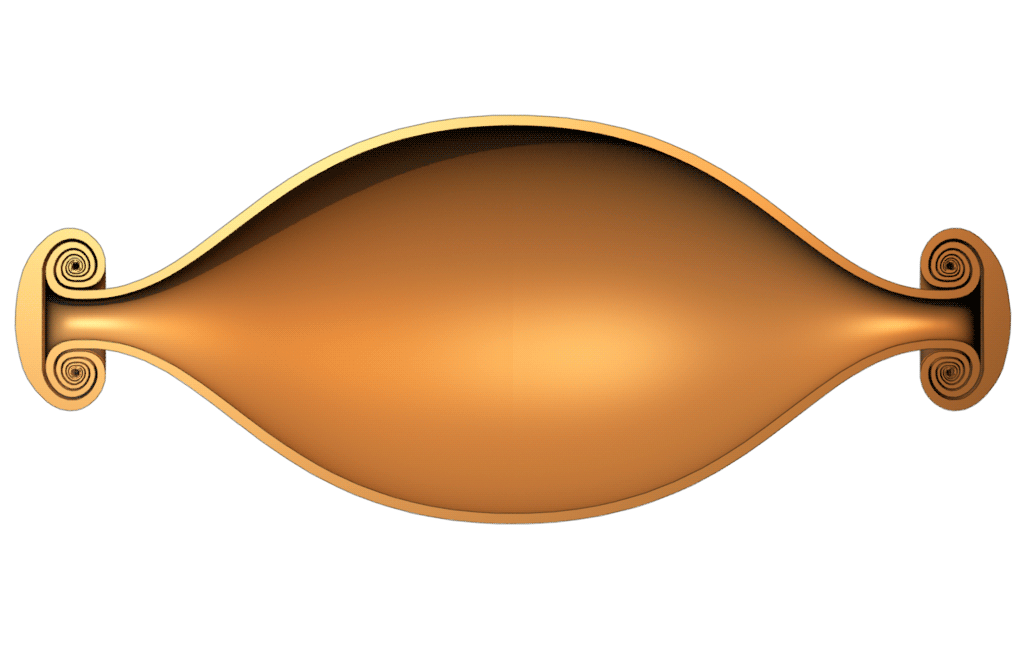The Exterior Tunnels
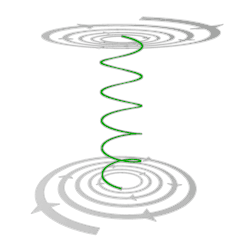
An exterior tunnel connects the low end of a spiral to the low end of another spiral of equal type that lies underneath or above the first spiral. Inner bridges below the central balance point do for some part the same thing, they connect two spiral arms of equal type at their inner ends. But the differences are that an inner bridge forms with a 90 degree turn between the spiral arm and the bridge, while a tunnel forms without making a 90 degree turn. And it connects two spiral arms that lie on the same plane, not two spirals that are located above each other. A consequence of these differences is that the tunnels are bigger than the inner bridges and their shape is different.
This class shares one characteristic with the outer bridges, namely that these vortices are never seen without the spirals. You will never find a tunnel without any of the spirals connected to its ends. This makes the tunnels, just like the outer bridges, easier to identify. There are two exceptions to this rule. One is when those spirals can not be visible because they're the state of equilibrium for the medium in which the outer bridge exists (for example, a swirl can not be visible underwater. This will be explained on the page about state of equilibrium). However, it is possible that a tunnel has only one connection to a spiral, and ends as a incomplete bridge at the other end. An exterior tunnel needs at least one spiral to exist. Another exception is the bubble vortex, but that vortex should perhaps not be classified as a tunnel.

Spirals that are connected to a tunnel vortex only make a flow movement, the whole vortex as a whole does not rotate. A swirl for example that is connected to a tunnel only makes a flow movement while other types of swirls might (not sure) make a rotating movement. The spiral of a whirlpool does only appear to flow, while the spiral of a hurricane appears to both flow and rotate. Yet I'm in some doubt because the observation of the latter is not an easy one.
The medium that exists within the hollow space of the tunnel is a different medium than the one in the surrounding medium. Inside some gyroducts we find plasma. Inside a whirlpool we can find air, inside a helix tunnel we sometimes find light. These are just some examples. The logic as to what medium can be found within a tunnel vortex is not known at this point. All the tunnel vortices also have a magnetic field associated to it, of which every field is a different shape for each type of tunnel.
Tunnels often form in explosions or intense impacts. The cradle forms with explosions in air, the exoduct forms with strong impacts in water. This difference between air, which is higher dimensional (more yin), and water, which is lower dimensional (more yang) is logical because explosions form vortices that are close to the same dimension level as the medium in which the explosion takes place, except that its a bit higher than that, about one dimension level.
Morph Sequence
All the exterior tunnels of the first half-cycle form one morph sequence. The spirals that are connected at both ends of a tunnel morph in the same way as those spirals of that type would normally do, and the tunnel vortex morphs along with the spiral vortices by morphing towards its subsequent tunnels. Only when the tunnel becomes a bubble than the connection to the spirals ends.
All of these vortices are hollow, this, and the observation that most of them are tubular in shape, is the main reason I decided to call them tunnels.
Helix tunnel
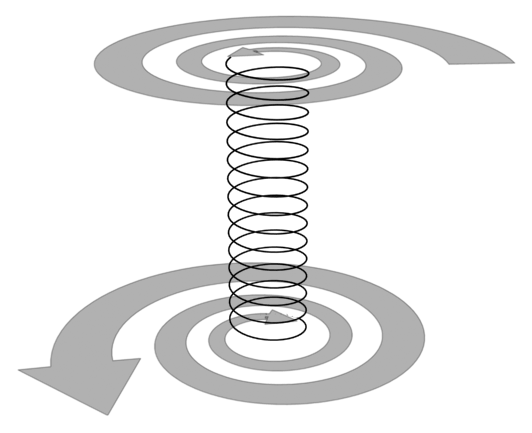
| Classification | Second exterior tunnel of the first cycle |
| Dimension | 0.75D inward to outward |
| Positive / Negative | Positive |
| Core | Yes |
| Periphery | No |
| Rotational sum movement | Yes |
| Minimum number of movements | Unknown |
| States of equilibrium |
Inorganic: Baked Clay Organic: Unknown |
| Origin of the name |
Helix because this vortex has the shape of a helix Tunnel because its vortex type is a tunnel |
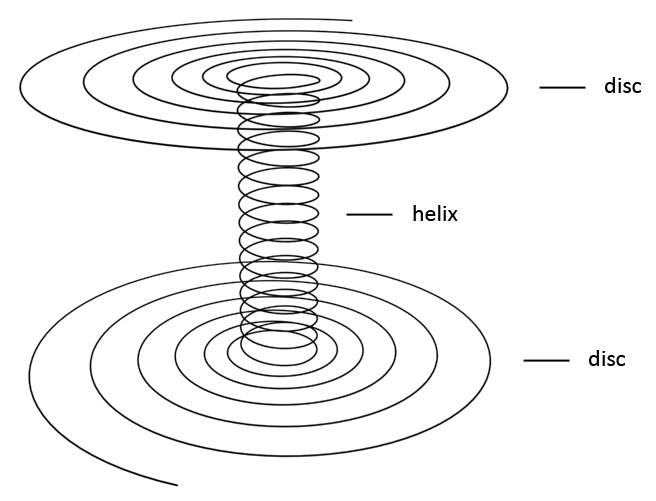
The vortex that connects two disc spirals at their open inner ends, making a hollow 0.75D bridge, is called the helix tunnel. The shape of this vortex is a basic shape of a helix. The helix tunnel connects to the inner end of a disc spiral at both ends. One of the spirals makes an inward movement, the other spiral an outward movement. The helix tunnel is a rotational vortex. The vortex is not visible when it is completely unmorphed, because it only has a core movement, not a peripheral movement. When an unmorphed helix tunnel morphs a bit upward, the helix becomes a visible vortex.
One visible observation of a helix tunnel connected to a disc spiral is the Norwegian spiral anomaly seen in 2009. The vortex is only half a tunnel, with the helix starting out as a point at one of its ends, and connecting to the disc at the other end. Both the helix tunnel and the disc are slightly highmorphed, because they're both visible.
The Norwegian Spiral Anomaly
The Norwegian spiral anomaly of 2009 appeared in the sky over Norway on 9 December 2009. It was visible from, and photographed from, northern Norway and Sweden. The spiral consisted of a blue beam of light with a greyish spiral emanating from one end of it. The light could be seen in all of Trondelag to the south and all across the three northern countries which compose Northern Norway, as well as from Northern Sweden and it lasted for 2-3 minutes.
According to sources, it looked like a blue light coming from behind a mountain, stopping in mid-air, and starting to spiral outwards. A similar, though less spectacular event had occurred in Norway the month before. Both events had the expected visual features of failed flights of Russian Bulava missiles, and the Russian Defense Ministry acknowledged shortly after that such an event had taken place on 9 December [text from Wikipedia].
What created the disc spiral is presumably the helix vortex made by the movement of the failed rocket launch. The Russian Bulava missile made a helical movement after one of its damaged nozzle's made the rocket enter a spin. The spin's direct result was the creation of the blueish helix seen close to the large spiral. That helix somehow forced the larger greyish spiral to form. The large spiral was not a direct result of the exhaust of the rocket engine, but is the result of a helix tunnel wanting to connect to a disc spiral.

Image by Odd Magne Haugen
The movement of the rocket can not be the only factor that resulted into the creation of this large spiral, otherwise it would be within our possibility to reproduce such a spiral with a small-scale experiment. What all the required conditions are for this phenomenon to occur is not known. An important fact is that this took place high in the sky. Weather conditions, temperature and type of propulsion used in the rockets are all factors to consider. There could be more man-induced factors playing a role here. Such a spiral does normally not occur in the natural world. If we understand these conditions better than we can reproduce such a spiral on a smaller scale. Such a smaller spiral will not have a lifespan as long as this large spiral in Norway, which had a fairly long lifespan because of its size.
The spiral above Norway is presumed to be a disc spiral connected to a helix tunnel, but there are at least two inconsistencies that raise doubt. First is that it appears in the photo that the length axis of the tunnel vortex does not make a 90 degree angle with the plane of the disc spiral. Instead it comes in at a different angle. Second inconsistency is that the center of the disc spiral is not open, but closed. Only shortly before the disc spiral disappeared it opened up at the center. A spiral connected to a tunnel should have an opening at the center.
Tungsten Filaments
The spiral above Norway created quite a lot of light. This light did not come from the rocket, the rocket engines were only active during the creation of the blueish helix. There are only two things I can say about this. The helix tunnel and the disc are both vortices that lie close to the zero point, and the zero point is where all the light comes from. It does not give a full explanation because I would expect a vortex only to emit light if it fully reaches the zero point. But the emittance of light from a helical shape can also be seen in tungsten filaments. Here too the helical shape might play a role in the creation of light. A tungsten filament might be a coil that creates a helix tunnel. Two major differences are that a tungsten filament is not in all, but in many cases a coil within a coil, thus twice a helix. And no disc spirals are seen at either of its ends. So I can not say it is certain that a tungsten filament is related to this tunnel vortex.
Image by Planemad (Wikimedia), under CC BY-SA 2.5 license
Tesla Coils
An example of a human invention of which the mechanism is based on the properties of a tunnel vortex is the Tesla coil. A Tesla coil is an electrical circuit invented by Nikola Tesla around 1891. It is used to produce high-voltage, low-current, high frequency alternating-current electricity. Its prime use is to generate electrical lightning.
The reason that this device successfully generates electrical lightning, is because like with other lightning, it is produced by a vortex that makes a 'wrong move'. The setup of a Tesla coil is similar to that of a tunnel vortex, with all the vortices of the correct class present and all of them located at the correct positions, but with the difference that the top spiral is a spiral of the wrong type, it is of four or six dimension levels higher than the correct composition of the tunnel vortex is supposed to have.
The result of this is that this vortex produces a huge amount of tension, which results into an inversion followed by a fallback as soon as certain limit is reached at which the vortex can no longer complete the attempted movement. This principle is explained on the page about tension and compression and on the page about inversion, and is one type of phenomenon that explains the mechanism of natural occurring lightning in our atmosphere.
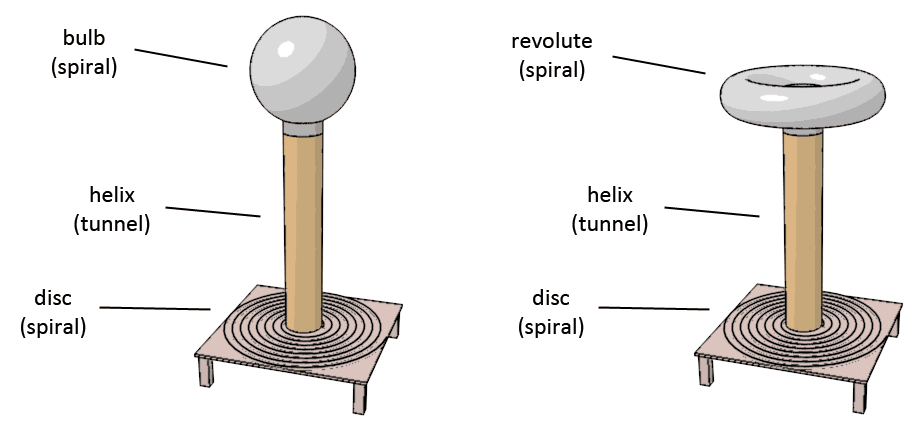
The correct top spiral should be a disc spiral, if we want the tunnel to be a correct tunnel vortex. Of course, the consequence of this is that the vortex then will no longer produce tension, and thus no longer produce lightning, so for a Tesla coil to function the above two configurations are correct configurations. The above two examples are Tesla coils with a bulb spiral and a revolute spiral at the top. Should we place a swirl spiral at the top of the Tesla coil, then this too will produce tension, but in less amount then the other two configurations. It might produce lightning as well, but it is logical that such a Tesla coil does not exist yet, because it is much harder to figure out how a swirl spiral should be produced (to my knowledge, no person yet has ever constructed a coil with the properties a swirl spiral).
The secondary coil, which in this case is the helix tunnel, has a lot of windings which are tightly packed together. It could be that the basic shape of a helix tunnel is closer to this coil than the images that I drew of a basic helix. Reason for this is that the magnetic field lines of a helical coil run straight upwards inside the coil, in a straight line. The movement of a core is perpendicular to that of its periphery. So if the movement of the monolith is straight upwards or downwards, then the movement of the helix tunnel must be close to horizontal. That is achieved by the tightly packed windings by which the movement stays almost horizontal.
Whirlpit
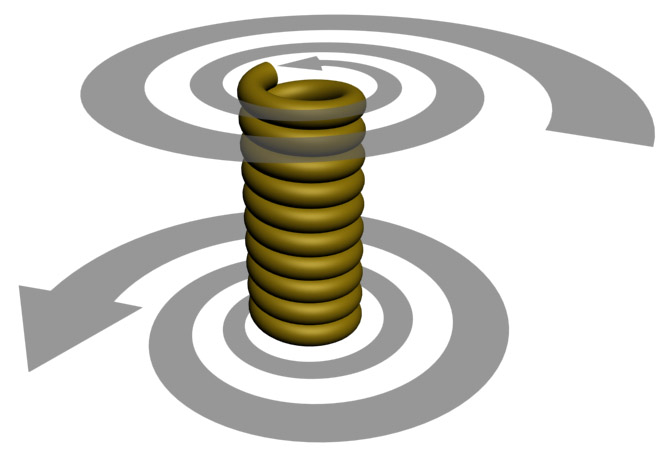
| Classification | Third exterior tunnel of the first cycle |
| Dimension | 1.75D inward to outward |
| Positive / Negative | Positive |
| Core | Yes |
| Periphery | Yes |
| Rotational sum movement | Yes |
| Minimum number of movements | Unknown |
| States of equilibrium |
Inorganic: Clay Organic: Unknown |
| Origin of the name | Whirlpit is another name for a whirlpool, which is what the top half of this vortex induces within a liquid medium |
The vortex that connects two swirls at their open inner ends, making a hollow 1.75D bridge, is called the whirlpit. The shape of the whirlpit is that of a hollow cylinder, a straight tube, of which the outer wall makes a helical movement, it is therefore a rotational vortex. Some whirlpits are long and narrow while others are short and wide. The whirlpit has a periphery, we know this because it is a visible vortex. Because the whirlpit connects to the inner end of two swirls, it is also likely that it has both a core and periphery. The whirlpit is the low dimensional equivalent of the gyroduct. One vortex lies 1,25 dimensions above the central balance point, the other lies 1,25 dimensions below the central balance point.
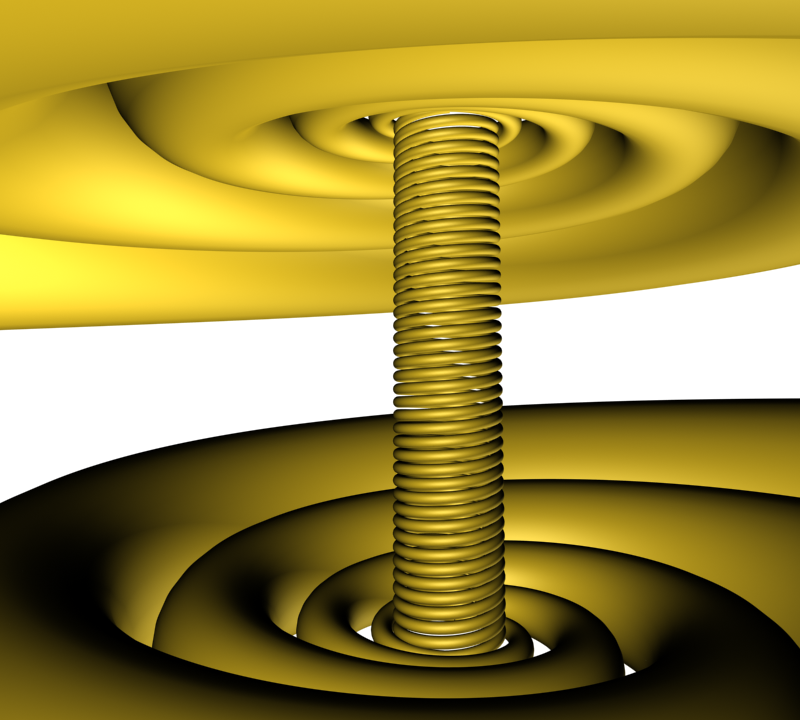
The picture above shows how a whirlpit looks like when it connects between two swirls. The vortex is hollow and makes a rotational movement around its length axis. I do not know if the swirls it connects to are single swirls or double swirls, thus with one spiral arm or two spiral arms.
What is not shown in this image is that the whirlpit makes a smooth turn with the swirls. There should be a funnel shape at the top and bottom. It could be that this smooth turn is the equivalent of the turns between the spirals and the ladders (or between spirals and inner bridges), but instead the turn goes in a different direction.
Two examples of a whirlpit are whirlpools (mesocyclic) and spiral galaxy ESO 137-001 (macrocyclic).
Whirlpools
A whirlpool is one vortex type that is easy to reproduce. All you need to do is pull out the plug in your bathtub and the flow of the water will create a whirlpool. You can also make a hole in the bottom of a container filled with water, sometimes you need to spin the container around a bit to get the vortex rotation going. Whirlpools can also form by opposing currents that meet at one location. The more powerful whirlpools are called maelstroms, yet most whirlpools are not that powerful and can be approached without much risk.
_UnderCCBYSA2.0.jpg) Image by Christine Westerback (Wikimedia), under CC BY-SA 2.0 license |
_UnderCCBYSA3.0.jpg) Image by Herzi Pinki (Wikimedia), under CC BY-SA 3.0 license |
A whirlpool, when viewed from underwater, does look a lot like a tornado (helicone) or a waterspout (helibar) depending on how straight or conic shaped the vortex is. The whirlpool however is not like those two types of vortices, despite its resemblance. A whirlpit is air-core and a tornado is not. The rotating mass is outside the tube, not within, so it kind of acts like its the inverted version of a tornado.
Above the water surface the upper swirl is clearly visible. A swirl can be seen on a water surface because the medium makes a transition between water and air. A swirl however can not be seen completely underwater, because the swirl is the state of equilibrium for water. The reason for this is something that will be explained later when you read the page about state of equilibrium. The consequence of this is that a whirlpit underwater does not end by connecting to a second swirl, instead it ends in a point. The shape of the tunnel becomes conical instead being mostly a straight tube.
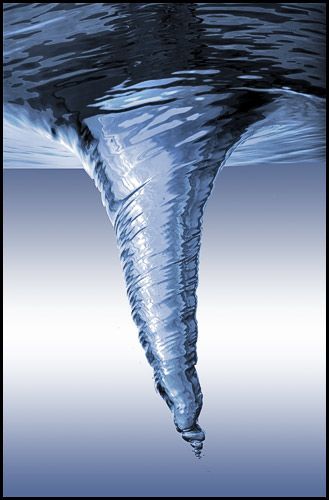
Vortex photo (c) Paul Groom Photography
for Hydro International
The swirl however is visible at the surface of the water, because there the water touches air. A vortex can be visible in a medium whose state of equilibrium is that very same medium only in two known situations. One is at the edge of that medium where the substance touches another medium, another is when the medium starts to oscillate.
Spiral Galaxy ESO 137-001
AndSergeMeunier_UnderCCBY3.0.jpg)
Image by NASA, ESA Acknowledgements: Ming Sun (UAH), and Serge Meunier
This image shows a whirlpit in outer space. It is spiral galaxy ESO 137-001 located in the cluster known as Abell 3627 (Norma Cluster). The galaxy has one swirl, and only a fraction of a whirlpit underneath. It might be that the remaining part of the whirlpit is still forming. The blue streaks streaming outwards from beneath the galaxy might be the volume of space around the whirlpit that is set into motion by the whirlpit and the swirl.
Exoduct

| Classification | Fourth exterior tunnel of the first cycle |
| Dimension | 2.75D inward to outward |
| Positive / Negative | Positive |
| Core | Yes |
| Periphery | Yes |
| Rotational sum movement | No |
| Minimum number of movements | Unknown |
| States of equilibrium |
Inorganic: Unknown Organic: Natural Latex |
| Origin of the name | Exo because it is an exterior vortex. Duct because of its tube shape, these last four letters letters are also in the names gyroduct and ultraduct, which are also tunnels |
The vortex that connects two bulbs at half way through of what should be the equivalence of the missing arms, making a hollow 2.75D bridge, is called the exoduct. The exoduct is a thick hollow tube that connects two bulb vortices oriented on top of each other. Unlike the whirlpit, this one does not show a rotation in its sum movement, it is a non-rotational vortex.
An exoduct can exist with only one or two spirals (which are bulbs) at its ends, but in can also coexist in conjunction with an exobar, which is an outer bridge. In that case the exterior tunnel is wrapped around the exobar, like a thick skin. Both these vortices connect exteriorly between two different bulbs, yet their class and shape is dissimilar.
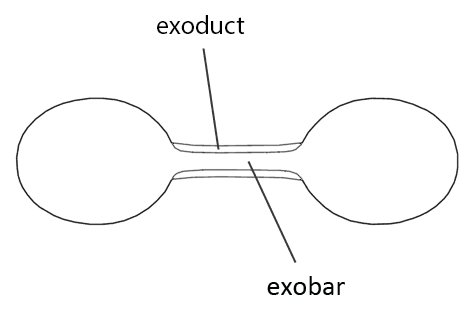
The same scenario can occur with a cradle and a pilaster. Both those vortices are of a different class and shape, but they both connect exteriorly between two different spirals, in this case two revolutes. The cradle and the palister are located two dimension levels higher in the sequence than the exoduct and the exobar, and the first pair of vortices can morph into the second pair of vortices, along with the spirals. The difference however is that the cradle is thinner than the exoduct and detached from the pilaster, while the exoduct is attached to the exobar.
Two examples of exoducts are underwater gunshots (mesocyclic) and some supercells (mesocyclic).
Underwater Gunshots
_Edited.jpg)
Screenshot taken from Youtube video by Richard Ryan. Image was edited with
lines and text.
An explosion in air can create a mushroom cloud, which is a revolute vortex of two dimension levels higher than air itself. On the other hand, and explosion in water can create a bulb, which is also two dimension levels higher than water itself. Along with the bulb other vortices in the sequence that connect to the bulb can also appear. In the case of a gunshot underwater, the initial explosion causes a bulb, while the rapid movement of the bullet through the water creates an exoduct tunnel that connects to the bulb.
No other bulb forms at the other end of the tunnel. With this method only half a tunnel forms. It could however be that an exobar also forms within the tunnel, which we might expect but is not clear from the video images. You can watch the full video by clicking on the link right below the image.
Supercell
Supercells are very strong thunderstorms that form when winds aloft cross surface winds, creating an updraft that whips clouds into a thunderous vortex. These types of storm are characterized by a deep, rotating updraft, for which they are sometimes referred to as rotating thunderstorms. They are the least common type of thunderstorm, but they have a high tendency to produce severe weather. If the environment is favorable, supercell thunderstorms can last for several hours.
_UnderCCBYNC2.0.jpg)
Image by Kelly DeLay, (Flickr), under CC BY-NC 2.0 license
Some, but not all supercells are exoduct vortices. The supercell can appear in several different shapes, it is only when the supercell takes in the form of a hollow cylinder (with a low density vortex inside) that it can be classified as a (lowmorph) exoduct. However, the upper bulb and lower bulb are never visible. This is because the bulb is the state of equilibrium for air, thus a bulb can not be visible in air. That is why we only see the tunnel. But we can see a vortex at one or two ends when those bulbs transform into lentillions due to dilation (those vortices are discussed on the page about the disks). In water however, both the exoduct and its two bulbs can be visible.
The exobar is often visible too in a supercell, yet at a much lower density than the exoduct. Its movement is also more vertical, perpendicular to the more horizontal movement of the exoduct. It also reaches all the way to the ground while the exoduct hovers higher up above the ground. Because a supercell always has at least some rotation, it is likely that the exoduct is a lowmorph exoduct, thus one that is an intermediate state between a whirlpit and an exoduct.
The supercell has been one of the hardest, or perhaps the hardest, vortex to classify. Still at this moment I'm still in doubt whether I've correctly classified this vortex as an exterior tunnel. The shape of the vortex looks dissimilar in most observations and for that it's not easy to be sure what the basic shape of the vortex is.
Cradle

| Classification | Fifth exterior tunnel of the first cycle |
| Dimension | 3.75D outward to inward |
| Positive / Negative | Positive |
| Core | Unknown |
| Periphery | Yes |
| Rotational sum movement | No |
| Minimum number of movements | Unknown |
| States of equilibrium |
Inorganic: Unknown Organic: Chicle |
| Origin of the name | It is named cradle because of the twin pylon, bulb and swirl conbination within the vortex that can represent two living organisms |
The vortex that connects two revolutes at their open outer ends, making a hollow 3.75D bridge, is called the cradle. This is a non-rotational vortex. Because this vortex connects to revolutes, it is unlikely that it has a core. This one is hard to classify into one class because it is one vortex that shows both characteristics of a tunnel and an outer bridge. It starts and ends at the outer end of two revolutes, just as the pilaster does, which is an outer bridge. The difference is that it is connected to the other spiral arm than the pilaster is connected to. It is difficult to determine what class of vortex this is. It is because of the movement of the vortex that I think that this is not an outer bridge. The movement in an outer bridge starts at the center and progresses into two opposite directions. The movement in this vortex starts in one end and then flows to the other end. That is the type of movement that a tunnel makes. So the best decision I can make with what I know at this point, is to classify this vortex as a tunnel.
Some large explosions show a funnel shaped collar that comes out of the underside of the revolute. This vortex moves very slow, indicating that its a high dimensional vortex. It forms when the revolute completes all the rotations of the inner windings that are part of the first spiral arm, then makes a u-turn (this is achieved with a gyroduct) and goes from contraction to expansion and then completes all the rotations that are part of the second spiral arm, thus becoming a full double spiral. The funnel that comes out of the revolute is what connects to the second arm of the double revolute.
This funnel is the first part of the cradle. But the full bridge never forms because there is only one full (left or right turning) revolute. If you look at the left photo you can see that a second revolute has partially formed just above ground level, which could be the reason that the bridge tries to form. For the full bridge to form there must be another revolute at the opposite side of the bridge which is strong enough to form the lower half of the cradle.
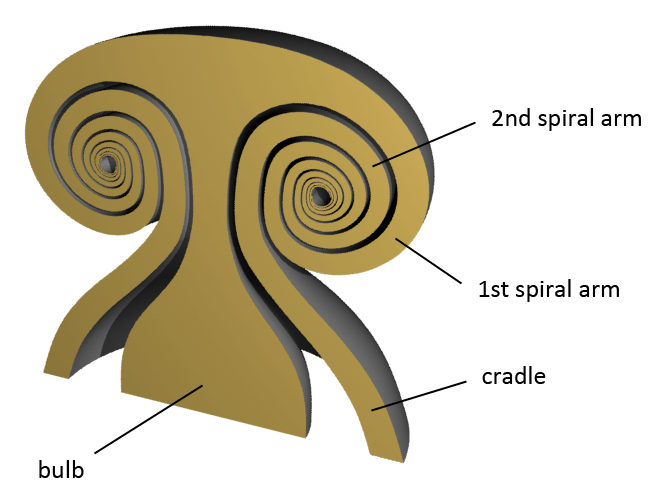
The image above shows how the bulb and cradle are connected to a double revolute. The image is a cross-section and shows how these vortices are connected in a full transformation sequence. What you may notice is that this image shows a bulb, while large explosions never show a bulb. As a matter of fact, a bulb vortex is never visible in air. The reason for this is that the bulb is the state of equilibrium for air. Air already behaves like one big bulb so a bulb vortex can not be visible in that medium (this will be explained on the page about state of equilibrium). Large explosions however do show the stem of the revolute which gets longer when the mushroom cloud rises into the air.
Three examples of cradles are seen in large explosions (mesocyclic), a viscous impacting drop (mesocyclic) and some lenticular galaxies (macrocyclic), like NGC 3115.
Large Explosions

RDS-6, 12 Aug 1953, the first Soviet test of a hydrogen bomb
Some, but not all large explosions form a mushroom cloud with an upside-down funnel forming underneath the mushroom head. This funnel only forms when the revolute vortex, which in this case is the head of the mushroom cloud, has two full spiral arms. This can happen when first the first spiral arm forms by making its inward flow rotations, then reversing its direction by either forming a gyroduct or a laminar belt at the inner end of the spiral, and then making a full outward flow rotational movement by forming the second spiral arm, which flows in the opposite direction. In most explosions, the second spiral arm doesn't fully form, but often a partial second arm does. Yet in no explosion a full cradle forms. Only at most nearly half a cradle. The reason for this is that the second revolute, and the second two sets of arms, are missing. The tunnel can not fully form because of the absence of the second spiral.
Viscous Impacting Drop
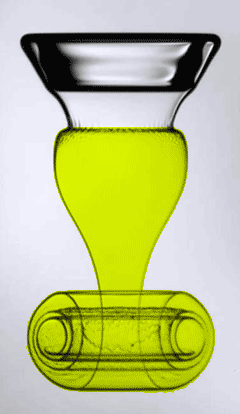 Image was edited with yellow markings |
Image and video by Er Qiang Li, D.Beilharz and S.Thoroddsen, under CC BY-NC 4.0 license |
This example shows a vortex generated by the impact of a viscous droplet into a liquid pool. The previous example showed a revolute with a cradle and a pilaster (or pylon). This example shows a revolute with only a cradle. The cradle is a little more than 50% formed, which is more than in the previous example.
The Spindle Galaxy, NGC 3115

Image by John Kormendy (University of Texas at Austin)
Most lenticular galaxies are not cradles, but some are, sometimes combined with a pilaster. Tunnels are normally not seen without the spirals, and not with at least one spiral if the tunnel is only half a tunnel. At both sides of this cradle you would expect a revolute. But only if you've read the page about state of equilibrium, then you already know why we do not see a revolute at both sides. The revolute is the equilibrium of the outer space medium (at the macrocyclic scale, not the mesocyclic). The outer space medium already behaves like one big revolute, so a revolute vortex can not be visible in space. That is why both ends of this vortex end in a point, those points are where this bridge connects to the revolute (which is the entire medium around it). What you cannot see in these Hubble images is that these galaxies are hollow, we know this because the cradle is a hollow vortex.
Bubble
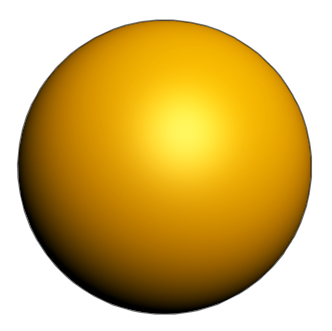
| Classification | Sixth exterior tunnel of the first cycle |
| Dimension | 4.75D |
| Positive / Negative | Positive |
| Core | Unknown |
| Periphery | Yes |
| Rotational sum movement | No |
| Minimum number of movements | Unknown |
| States of equilibrium |
Inorganic: Unknown Organic: Soap |
| Origin of the name | It is called a bubble because this vortex is known as a bubble in several mediums |
The shape of this non-rotational vortex is that of a sphere, a hollow sphere, with only a very thin outer surface. I am not sure if this vortex should be classified as a tunnel. In its only known form it does not appear to connect two scroll rings, thus it does not connect two spirals. It is a stand-alone vortex, yet it is the vortex that comes after the cradle in the morph sequence. This vortex is located on the same dimension level as the wake belt, and it too can produce spectral colors. This is one of the subtle clues that suggest that a soap bubble for instance could have the same dimensionality as the wake belt, which is the same dimensionality of the remaining exterior tunnel.
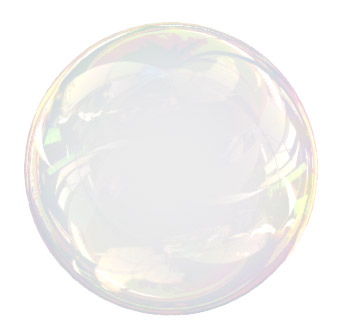
Yet it can not connect to scroll rings because the passage from one scroll ring to the other is blocked by other vortices in the sequence, it is blocked by the revolutes. I might need to change the classification for this exterior tunnel later if we find out that this vortex is of a different type.
When a cradle morphs into a bubble, the connection to the spirals breaks off while the cradle becomes more round and changes into a spherical vortex. Another difference between the cradle and the bubble is that a bubble is transparent, while a cradle is not.
We know this vortex in the form of soap bubbles. Yet it should be possible to find this vortex in different mediums, which might make it look like a different vortex at first glance because of its color and texture, but the shape is expected to be round in all mediums.
There is one particular property of this non-rotational vortex type that is not seen with any other identified vortex types so far, and that property is its scalability. A bubble can grow and shrink with very little effort, while with other vortex types it is not even possible or it takes very much energy. It is not exactly clear as to why this vortex type exhibits this property, while others do not.
Are exterior tunnels components of a bigger vortex?
I have some doubts whether exterior tunnels are no more than a combination of three different vortices, two spirals and one tunnel, or that these vortices are the components of yet a bigger vortex, one that hasn't been identified yet. It could be that these tunnel vortices form the central axis of a larger, ellipsoidal vortex, or the central axis of an orb, which could exist but hasn't been seen yet as a whole, only the part that forms the central axis.
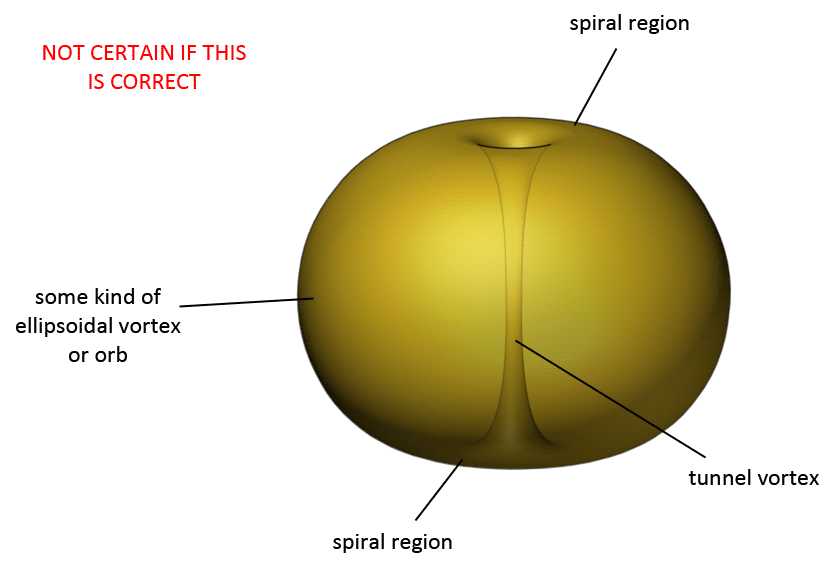
It could be that these individual vortices belong to the first cycle. But the vortices combined together as an orb or ellipsoidal belong to another, higher cycle. It is not possible at this point to confirm whether this is correct, because no such observation has been made.
| All content on this site that is authored by Peter.A.Venis is licensed under the Creative Commons CC BY 4.0 license, unless otherwise mentioned. Most pages on this website also include material from other authors, under different licenses. Both the author's names and the licenses are mentioned in the file names whenever this information is known and can be provided. The presence of work from other authors on this website does not necessarily imply that those authors endorse the contents of this website. |
| A word that is often used on this website is the word 'vortex'. Many sources describe a vortex as a movement in a fluid that has a rotational flow. Yet many of the vortices that I describe on this website do not show a visible rotational flow. I took the liberty of using the word vortex for describing a phenomenon that had not been understood before, one that links together rotational and non-rotational movements. Even a movement in a straight line can in some cases be categorized as a vortex, if it is known that that movement is created by certain identical conditions. So keep in mind that the word 'vortex', within the context of the infinity-theory, has not the exact same meaning as other sources describe. |





_UnderCCBYSA2.5.JPG)
